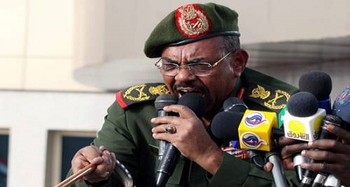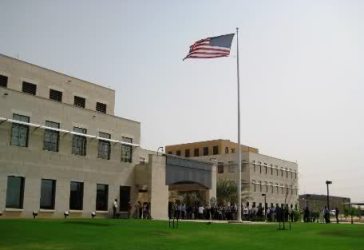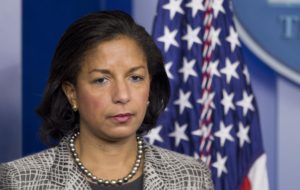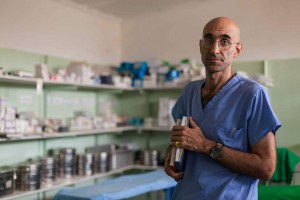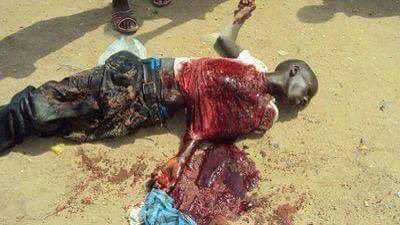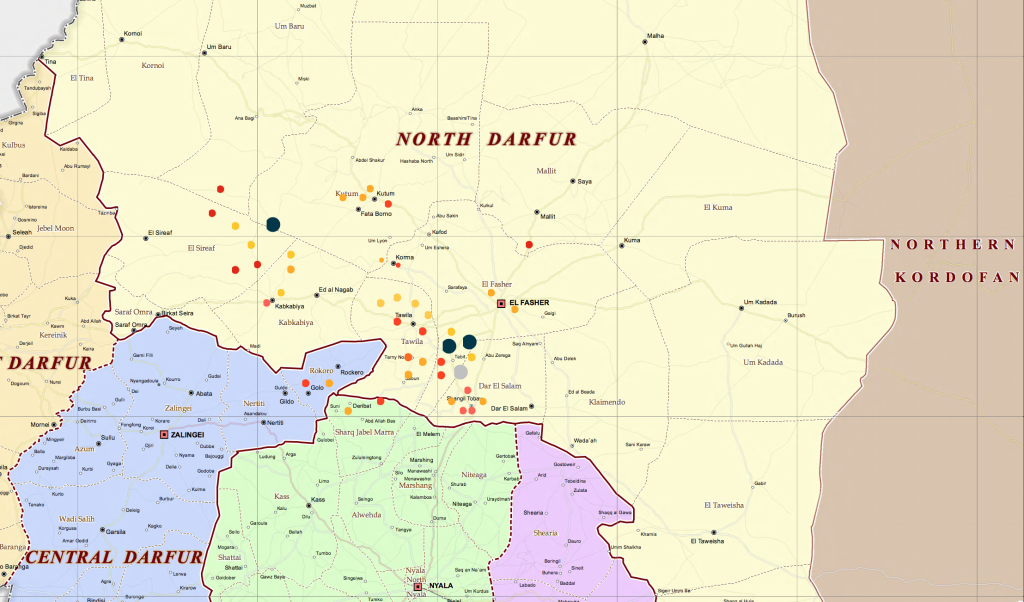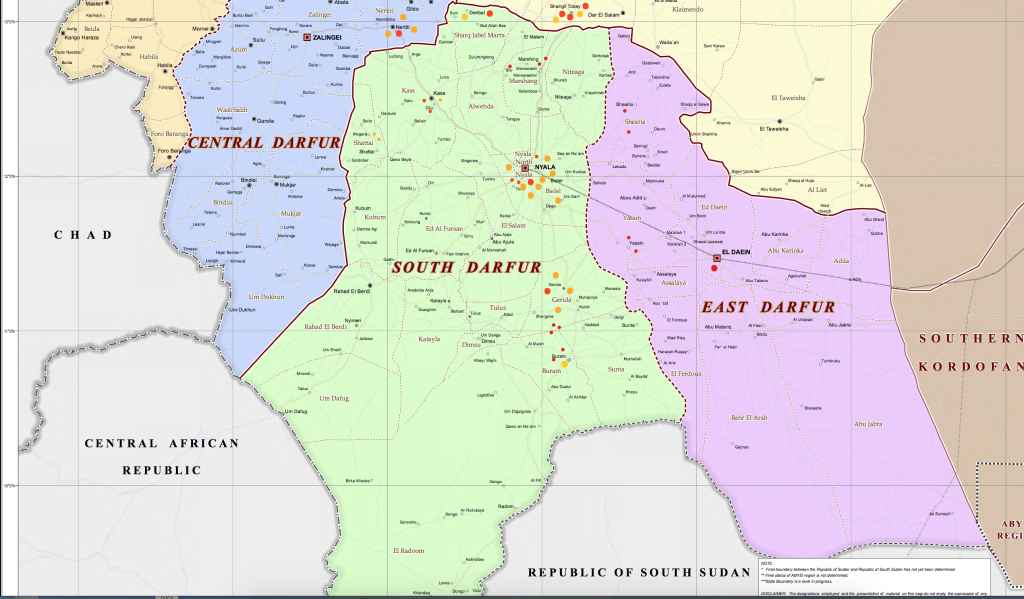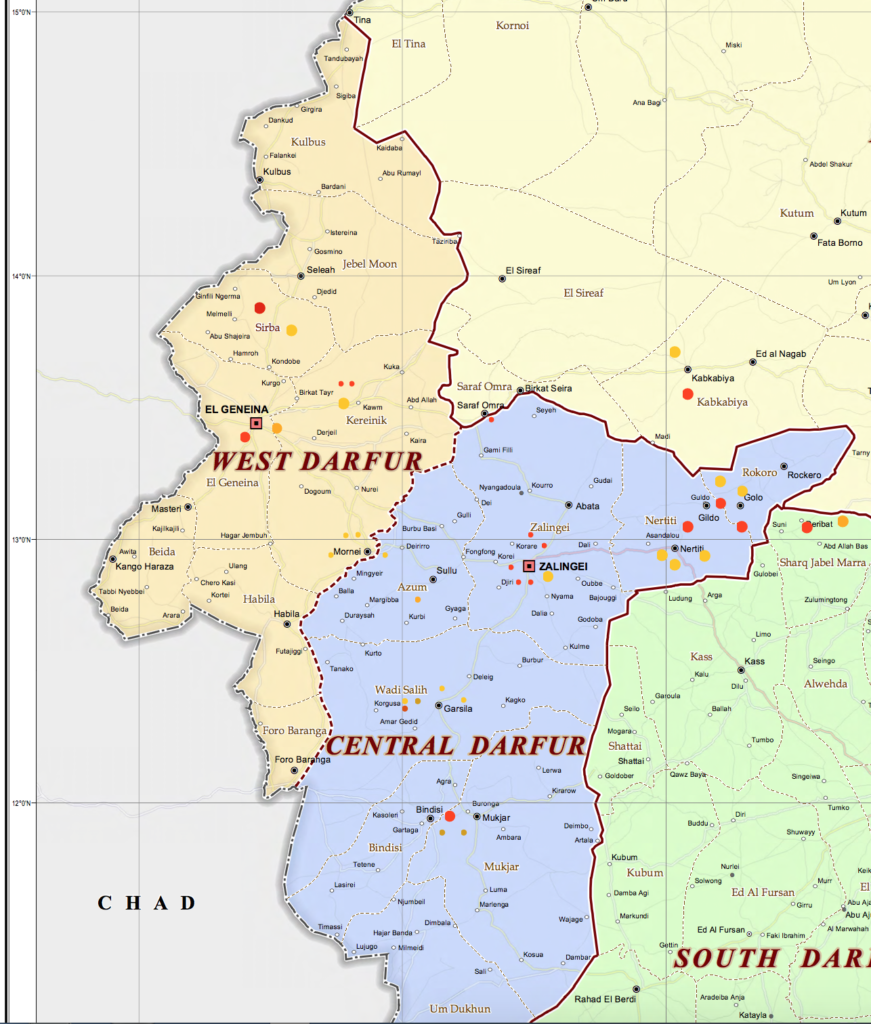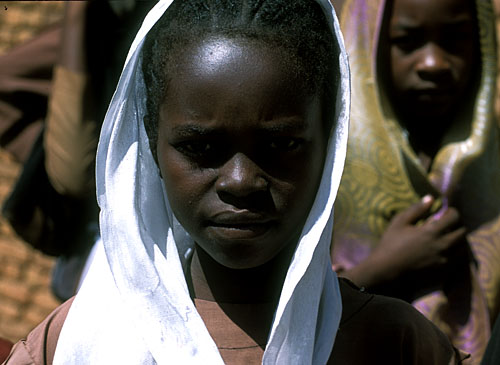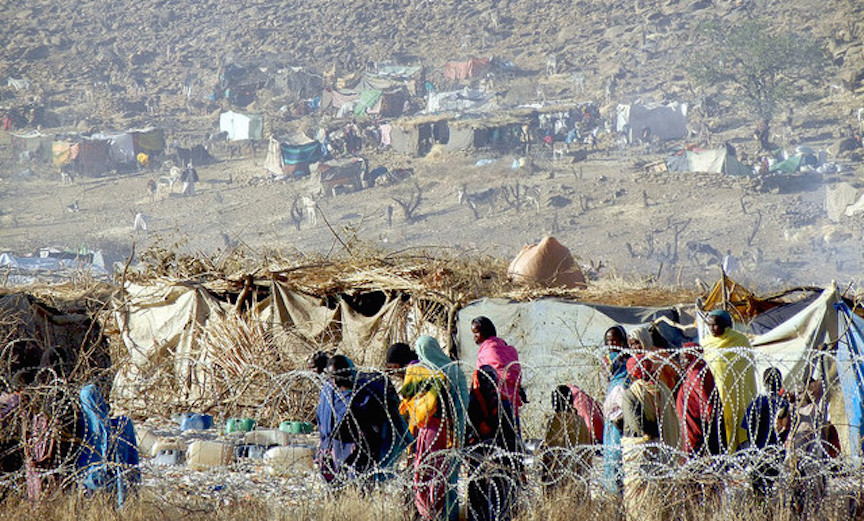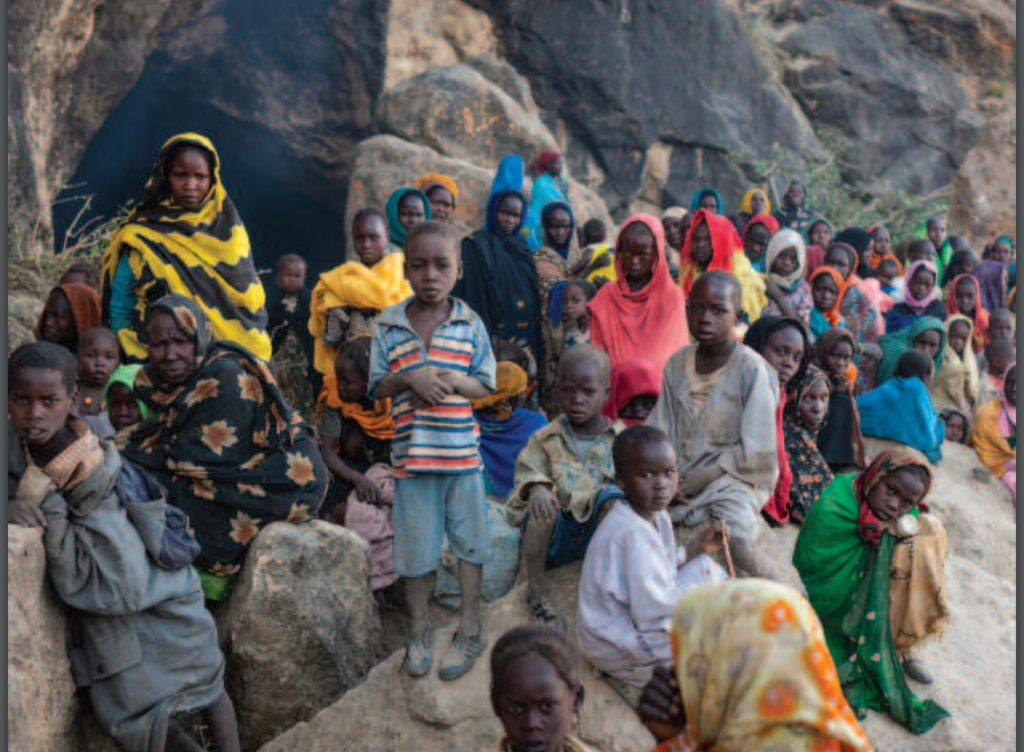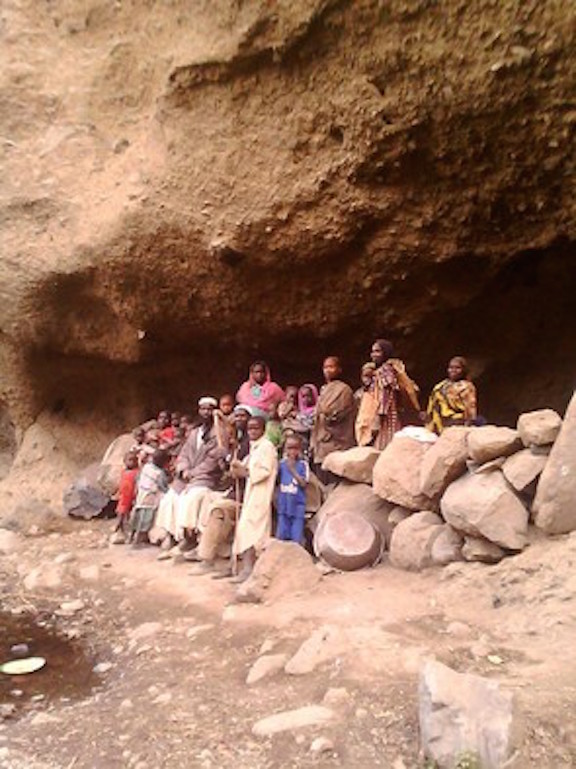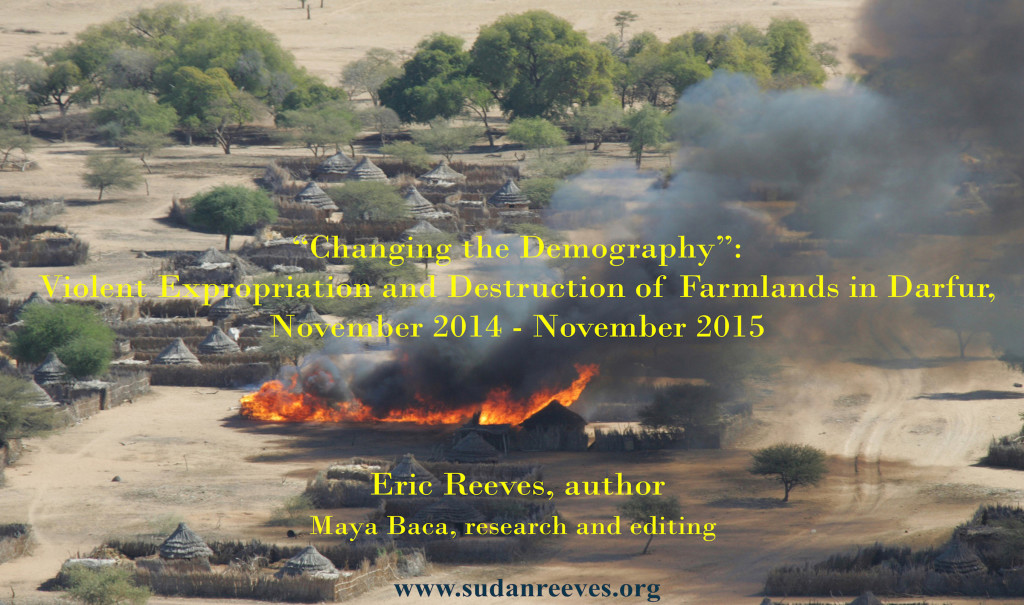Quantifying Human Destruction and Suffering in Sudan: The grim calculus of international policies and politics
Eric Reeves | February 12, 2017 | http://wp.me/p45rOG-21m
Sudan Tribune | February 13, 2017
Towards the end of her long chapter on the Rwanda genocide in “A Problem From Hell” (2002), Samantha Power renders a moment from this terrible international failure that has long haunted me. It is both unforgettable in its implications and points to far too much that is unforgivable. The moment occurred in late July 1994 as the U.S. under then-President Bill Clinton finally managed to step away from its absurd sophistries and the moral cowardice that had defined American policy during the horrific months of carnage, which were at this point essentially over. Prior to the deployment of 200 U.S. troops to protect the Kigali airport, the UN force commander of UNAMIR, Lt.-General Rómeo Dallaire, received a phone call:
A U.S. officer was wondering about precisely how many Rwandans had died. Dallaire was puzzled and asked why he wanted to know. “We are doing our calculations back here,” the U.S. officer said, “and one American casualty is worth about 85,000 Rwandan dead.” (page 381, “A Problem from Hell”: America and the Age of Genocide)
I see no reason to doubt Dallaire’s recollection, offered less than eight years after the events of spring 1994—and certainly not having met with Dallaire and encountered the searing authority and detail of his soul-destroying memoire, Shake Hands with the Devil: Humanity’s Failure in Rwanda. Moreover, what struck me as such an obscene calculus on the part of the U.S. military in 1994 no longer seems so strange. Indeed, in one form or another, it governs current actions by the U.S. military—in all its dimensions and guises—every day. The assessment of civilian casualty risks in U.S. drone strikes on suspected terrorist locations is only one example. No, what seems strange to me now is that any U.S. military officer would venture to be so specific about a calculus that included such a ratio: “one American casualty is worth about 85,000 Rwandan dead.”
UN force commander of UNAMIR, Lt.-General Rómeo Dallaire
Perhaps the savage cynicism in such a calculus was simply too conspicuously in evidence. Certainly Susan Rice, then young in her government career, came to regret an equally cynical comment—recorded by Power in the same chapter, about actually “doing something,” even daring to use the word “genocide” (this in late April of 1994):
…Susan Rice, a rising star on the NSC…stunned a few of the officials present when she asked, “If we use the word ‘genocide’ and are seen as doing nothing, what will be the effect on the November [congressional] elections?” Lieutenant Colonel [Tony] Marley remembers the incredulity of his colleagues at the State Department. “We could believe that people would wonder that,” he says, “but not that they would actually voice it.” (page 359)
[Power’s paragraph concludes: “Rice does not recall the incident but concedes, ‘If I said it, it was completely inappropriate, as well as irrelevant.’” – Yes…yes indeed…]
What I attempt here is an overview analysis of the quantitative implications that follow from continuation of such a ghastly and cynical calculus in other forms, specifically the forms it takes in the Sudan policies of various international actors of consequence. For in fact, this cynicism lies behind the disingenuousness, mendacity, and deliberate ignorance of so much that defines the Sudan policies of Western nations, the UN, the African Union, the Arab League, and the Organization of Islamic Conference. It is finally the same cynicism as experienced by General Dallaire and given voice by Susan Rice.
The Savage Calculus at Work
The calculus I adumbrate is certainly not peculiarly American. European countries, particularly the UK and Germany, are desperate to stem the flow of African refugees to the European continent; and they have calculated that the benefits to stanching this flow justifies a policy of rapprochement with the National Islamic Front/National Congress Party regime in Khartoum. To be sure, European policy is also animated by commercial and other economic interests. Europe has never seen an obligation to impose economic sanctions on the Khartoum regime, even when in 2004 the Parliament of the European Union, almost unanimously, declared that the actions of that regime in Darfur were “tantamount to genocide.” Economic and commercial interests have long prevailed, despite unctuous public pronouncements of concern by various European leaders.
So conspicuous has the hypocrisy of Europe been that French banking giant BNP Paribas was emboldened, in the interest of huge profits, to abandon all concern for any atrocities committed by the Khartoum regime. In doing so it deliberately chose to violate U.S. financial sanctions on a massive scale—from within the U.S. itself. This led to the 2015 criminal conviction of BNP Paribas by the U.S. Justice Department—for violations so flagrant that the Deputy Attorney General described BNP Paribas as Khartoum’s “central banker” abroad, thereby insulating the regime from the most serious consequences of the most significant element of U.S. sanctions. There was no moral calculus at all—no regard whatsoever for the destructive consequences of providing “financial save haven” to a regime has engaged in brutal, finally genocidal counter-insurgency wars on Sudan’s peripheries since 1989. The details for the years 1997 – 2007 are outlined in extraordinary detail in a class action civil suit filed on behalf of Sudanese victims (in U.S. District Court, Southern District of New York, Case 1:16-cv-03228-AJN; full text of the Complaint is available upon request).
Senior official of BNP Paribas–before the guilty plea that would cost the bank some $9 billion in forfeitures and fines
The Sudanese Economy Without BNP Paribas as de facto Central Banker
The Sudan policies of most European governments are guided by the willfully ignorant and self-serving economic “calculation” that somehow the people of Sudan will be helped if a savagely repressive, self-enriching, and genocidal regime is preserved. The evidence to the contrary here is simply overwhelming and makes nonsense of any such calculation as it informs European policies, whatever fig-leaf of “country concern” is provided. The realities are that the regime continues to function conspicuously as an extremely powerful kleptocracy, with policies of self-enrichment that are now badly undermining the country’s economy (see http://sudanreeves.org/2015/12/09/7041/).
That economy is in an irreversible nose-dive, a collapse catalyzed by the desperately inadequate investment policies of the past decade and more, indeed since oil revenues began pouring into Khartoum in 1999. There has been no meaningful investment in agriculture; the sector that should be the backbone of the economy is collapsing, even the famous Gezira Scheme. At the same time, severe water shortages are constantly reported from around the country; these are but one reflection of the regime’s refusal to invest in infrastructure projects than benefit the general population of Sudan. The current, widespread outbreak of deadly cholera in Sudan can be traced directly to the failure to provide adequate supplies of clean water, especially in places like Port Sudan, where the minority Beja population is so numerous. Nor was any adequate refining capacity built during the years flush with petro-dollars; now Sudan is forced to import large quantities of refined petroleum products, including cooking fuel, prices for which have skyrocketed for a number of years.
In refusing to plan for the loss of oil revenues that came with the 2011 secession of South Sudan, Khartoum set in motion a series of cascading economic crises. Foremost among them was the sharp decline in the influx of hard currency. Without the foreign exchange currency (Forex) that had been generated by large oil exports, Khartoum has been unable to purchase sufficient quantities of critical items from abroad, including not only cooking fuel, but urgently needed medicines, and even wheat to make into flour for bread, the staple food for many. Bread prices have also seen an enormous spike, and there are severe shortages as well as long lines for purchase. Broader inflation is likely in the range of 50 percent, and perhaps higher.
There are no reliable inflation figures from either the regime or the IMF, the latter another corrupt actor in international policy views of Sudan. In an October 2013 “IMF News Release,” Edward Gemayel, the IMF’s Mission Chief for Sudan, declared that: “Sudan has a long track record of implementing sustainable economic policies” (http://www.4-traders.com/news/IMF-International-Monetary-Fund-Press-Release-Sudan-Meeting-of-the-Technical-Working-Group-on-E–17345158/). Preposterous and demonstrably false declarations such as this have served the Khartoum regime well for the past two decades. But economic realities are not hard to discern, despite the mendacity of men like Gemayel.
How, we must wonder, would Gemayel characterize the current military and security budget for the Khartoum regime as demonstrating “a long track record of implementing sustainable economic policies,” particularly in light of the allocation percentages and the final remark by President al-Bashir? —
Sudan allocates $1.8 billion for defense in 2017 | Sudan Tribune, December 23, 2016 (KHARTOUM) – Sudan has appropriated more than 29 billion pounds (SDG) (about $1.8 billion) to defense and security which represents the largest single spending item in the 2017 budget. According to Sudan’s 2017 budgetary estimates seen by Sudan Tribune, 5 billion pounds have been allocated to the sovereign sector while 2.3 billion was appropriated for agriculture and forests spending. Other budget spending items includes 1.9 billion for the economic sector, 5.5 million for culture and information, 5.3 million for health, 828 million for education, 1.7 billion for minerals and 1.7 billion for transport, roads and bridges.
It is noteworthy that the combined education and health spending represents about 3% of spending on defence and security.
The Sudanese army has been fighting Sudan People’s Liberation Movement/North (SPLM-N) rebels in Blue Nile and South Kordofan since 2011 and a group of armed movements in Darfur since 2003. Sudan’s security apparatus has expanded vastly and military expenditure continued to rise as the government relies increasingly on militias such as the Popular Defense Forces (PDF) and the Rapid Support Forces (SRF) in military operations.
Last year, Sudan’s President Omer al-Bashir said,
“If 100% of the state’s budget was allocated to the army to secure the country, then that is still not enough.”
The Khartoum regime’s leading “economist,” indicted génocidaire and President Omar al-Bashir
Given such budgetary priorities, it is hardly surprising that the value of the Sudanese Pound—the best barometer of the general availability of hard currency (inside and outside the Central Bank of Sudan)—has been declining precipitously for several years, reaching record low after record low—all thoroughly reported. Only cash infusions from Saudi Arabia and the Gulf States keeps the economy from utter catastrophe. These infusions are seen as the necessary cost of preserving estrangement between Khartoum and Iran, formerly the regime’s “key strategic ally” (see leaked minutes from meeting of senior regime military and security officials, August 31, 2014: http://sudanreeves.org/2014/10/22/new-and-exceedingly-accurate-translation-into-e/).
If Europe, the UN, the IMF and others would only look honestly at the economic policies of the NIF/NCP regime, going back to the military coup that brought it to power in 1989, they would of course see that whatever putative gains may be realized by normalizing relations with this junta, the policies of rapprochement only provide support for economic self-destruction destruction and ongoing genocidal tyranny. The regime feels emboldened because of the widespread, deliberate ignoring of news from Sudanese news sources, news that if taken seriously would interfere with the counter-productive international policies now firmly in place.
So spectacular is the ignorance required to justify European policy views, that it is finally not credible: what we are witnessing is not true ignorance (although there is plenty of this) but “ignorance by selectivity.” By picking and choosing which reports seem to justify current policies, the Europeans have effectively created their state of ignorance. The three major human rights reports on Sudan of the past two years by Amnesty International and Human Rights Watch have gained no real traction, despite the horrific atrocities documented on the basis of countless interviews conducted by researchers for these reports.
In the end the conclusion is inevitable: the European economic and refugee policies in place and being implemented are simply the European version of a statement made by the U.S. Special Envoy for the Sudan, Princeton Lyman, in December 2011:
“We [the Obama administration] do not want to see the ouster of the [Khartoum] regime, nor regime change. We want to see the regime carrying out reform via constitutional democratic measures.” (Interview with Asharq al-Awsat, December 3, 2011 | http://english.aawsat.com/2011/12/article55244147/asharq-al-awsat-talks-to-us-special-envoy-to-sudan-princeton-lyman)
Former Obama administration special envoy for the Sudans, Princeton Lyman
The U.S. Calculus for Sudan
In the case of the U.S., at least since the terrorist attacks of September 11, Sudan policy has increasingly reflected a trade-off between, on the one hand, the putative value of Khartoum’s providing counter-terrorism intelligence and, on the other, the knowledge that in providing critical diplomatic cover for the survival of the NIF/NCP regime, the U.S. is complicit in the repression and atrocity crimes of that regime.
Certainly any survey of what has transpired between Lyman’s interview of December 2011 and the present, certainly in the way of political “reform,” makes clear how preposterous his assertion was. Also clear are the brutal consequences of his deliberately false suggestion about what the NIF/NCP regime is capable of. For of course Lyman was not so ignorant as to have believed that the regime could actually preside over “reform [of Sudan] via constitutional measures.” Rather, it was a statement made to preserve the status quo in relations between Khartoum and the Obama administration, which was continuing policies begun under the Bush administration and which have been consistently defined by demands from the U.S. intelligence community. Khartoum, as a senior regime official recently boasted, now is home to one of the largest and most important U.S. intelligence listening posts in the Middle East (see photo).
To put the matter in terms that would be familiar to General Dallaire, Lyman was implicitly declaring that such a trade-off was “worth it” in terms of American lives saved from potential terrorists threats, working on the problematic assumption that Khartoum could help us avert such threats. Lyman made this calculation on behalf of the Obama administration, knowing that he was speaking about a regime that would continue to impose catastrophic humanitarian embargoes on many hundreds of thousands of Sudanese civilians, embargoes that continue to this day; a regime that would mercilessly and continuously bomb civilians in various regions of the country; a regime that soon after Lyman’s statement would replace the Janjaweed of Darfur with the much better armed and organized militia force known as the Rapid Support Forces wreaking even more terrible havoc; and a regime that would be perfectly capable of using chemical weapons, as it did during the 2016 military campaign of extermination in the Jebel Marra region of Darfur:
(“Scorched Earth, Poisoned Air: Sudanese Government Forces Ravage Jebel Marra, Darfur,” Amnesty International | 109 pages; released September 29, 2016).
And as for political “reform,” what we have seen in Sudan during the five intervening years is a dramatic growth in repression, increasing numbers of arrests and torturing of human rights advocates (singling our Darfuri students in the greater Khartoum area in particular), a severe curtailment of the press, the killing of civilians in September 2013 by security forces that had been issued “shoot to kill” orders—and a re-issuing of the threat to institute such orders by President Omar al-Bashir in December 2016.
Lyman and the Obama administration knew, could not possibly have been ignorant, of the implications of the deal that Lyman was announcing with his interview statement of December 2011. Khartoum, of course, readily accepted the deal—one that has progressed to the point where, in its closing days, the Obama administration decided to lift economic sanctions on Khartoum, a decision subject to review in July 2017 but which the ignorant and malignant Trump administration is hardly likely to reverse, should it even taken notice of the obligation of review—an increasingly unlikely prospect, given the chaos evident in every quarter of the new administration. Khartoum’s recent boast, reported by Sudan Tribune, January 31, 2017—
The Central Intelligence Agency (CIA) office in Khartoum is the largest one in the Middle East, said the Sudanese intelligence General Hanafi Abdallah, to give an idea about the importance of intelligence cooperation between the two countries—
—even if somewhat hyperbolic, reflects confidence that the U.S. will not dare surrender the relatively recent activation of its Khartoum-based intelligence listening post.
In lifting sanctions on Khartoum, the Obama administration was so eager to justify its decision that it resorted to permitting outright falsehoods to be deployed. One apt response to the decision came from Leslie Lefkow, deputy Africa director at Human Rights Watch, who called the decision simply “inexplicable”:
“There has been no progress on human rights. Sudan’s government has failed to make progress on core benchmarks, from its ongoing war crimes and crimes against humanity in Darfur and other conflict zones, to its extensive repression of independent voices, [Lefkow said].” (Reuters, Washington DC | January 13, 2017)
But most conspicuous among these falsehoods was the claim by Obama administration Ambassador to the UN Samantha Power, who declared in her final press interview that there had been a “sea change” of improvement in humanitarian access in Sudan. This is patently false, as the State Department has privately made clear. Conspicuously, there has been no public explanation—from any official of either the Obama or Trump administration—of how this claim comports with facts on the ground in Sudan. It is a falsehood that stands as the official view of the U.S. government.
Here we should note that this means a correction has not been offered by key former officials of the Obama administration, including Power herself and National Security Advisor Susan Rice, who is a former Assistant Secretary of State for African Affairs and knows Sudan well—and knows that Power’s claim is deeply and consequentially false. Why hasn’t she spoken out to offer a correction? And why haven’t we heard from Gayle Smith, formerly a senior official for African Affairs in Obama’s National Security Council and who was Administrator of the U.S. Agency for International Development until January 20, a week after Power’s press interview? She knows perhaps better than anyone in the former Obama administration how false Power’s claim is: why has she said nothing? Why has she offered no correction?
Obama administration National Security Advisor, and former Assistant Secretary of State for African Affairs, Susan Rice: she surely knows there has been no “sea change” in improved humanitarian access in Sudan…why won’t she say as much?
This is hardly a small matter. Khartoum—which knows perfectly well that it has done nothing to earn the praise that it has been accorded (a “see change” in improved humanitarian access)—will prove only more intransigent in truly improving access for relief workers and supplies. Particularly hard hit will be the areas of the Nuba Mountains that remain, to this very day, under Khartoum’s savagely cruel humanitarian embargo. An experienced and highly knowledgeable humanitarian on the ground in the Nuba conveyed to me his reaction to Power’s “sea change” claim:
“…there’s been absolutely no change in humanitarian access [in the Nuba Mountains—suffering under Khartoum’s humanitarian embargo for over five and a half years]. Not a single grain of sorghum nor one tablet of medicine has entered Nuba from any of the usual humanitarian agencies.” (email from Dr. Tom Catena, the only surgeon operating in the Nuba Mountains; received January 17, 2017)
In an email received today (February 12, 2017) Dr. Catena offered a grim update on the consequences of the humanitarian embargo:
“The situation here is still the same. Everyone had a poor harvest and is running short of food. The food available in the market is unaffordable for all but a few people. It’s going to be a long year.”
Dr. Tom Catena, the only surgeon currently working in the Nuba Mountains of South Kordofan
As this communication makes clear, the consequences of Khartoum’s denial of humanitarian access may well be measured in thousands of lives lost, perhaps tens of thousands if we bear in mind the humanitarian embargo on large parts of Blue Nile and many locations in Darfur. A very recent “Flash Update” from the “South Kordofan/Blue Nile Coordinating Unit” (#14 | February 11, 2017) offers a very grim account that comports all too fully with Dr. Catena’s:
“Deteriorating Food Security Outlook Following Poor Harvest Assessment”
The recently released Food Security Monitoring Unit (FSMU) report for the period of December 2016 describes a “bleak food security outlook” based on declining harvests compared to the same period last year. According to an early harvest assessment and a decrease in rainfall reported by FEWSNet*, there is a strong indication the region will experience a decline in food production in 2017. This will further increase strain on traditional coping methods and indicates an early onset to the annual lean season…
[Famine Early Warning Systems Network and the US Geological Survey release satellite data on regional evapotranspiration and deviation from historical norms. This measure, the Evapotranspiration Anomaly Index, is a reliable proxy indicator for rainfall. As facilities to directly measure rainfall throughout the area are not available this serves as the best measure for seasonal rains.]
Presumably this, too, is all part of the Obama administration’s Sudan policy “calculus.” For if Khartoum believes that the Obama administration has in fact credited the regime with what it has not done, this powerfully diminishes the incentive for a supremely canny regime to meet the supposed “benchmark criterion” for keeping sanctions lifted (one of only two meaningful criteria in President Obama’s Executive Order lifting sanctions). Moreover, it seems extremely unlikely that the character of humanitarian access in Sudan will become an issue during the confused opening months of a Trump administration, an administration that seems incapable of appointing anyone to any position who will taken seriously this critical issue, with life and death implications for many hundreds of thousands of people.
The man who will ultimately decide whether economic sanctions on Khartoum should be lifted permanently
The Ultimate Cynicism
The countries of the West—particularly in North America and Europe—like to think that they are morally superior to such ruthlessly and destructively self-interested actors as Russia and China—and increasingly the African Union, especially its Peace and Security Council. They like to think that the UN would function effectively but for the obstructionist roles of Russia and China on the UN Security Council. But Western “outrage” at the undeniable obstructionism on the part of Russia and China is largely belied when the same “outraged” countries engage in policies that in their way are all too similarly self-interested, offering Sudan only a veneer of moral concern.
The U.S. Criteria for Continuing with Lifting of Sanctions
Besides humanitarian access, the benchmarks for Khartoum to meet in maintaining a suspension of U.S. sanctions are three:
[1] No longer supporting the maniacal Lord’s Resistance Army (LRA), which has been reliably reported in the Kafia Kingi enclave—part of South Sudan but controlled militarily by Khartoum; for years Khartoum used the LRA as a fantastically brutal proxy in its war with the South and subsequently—this as a means of gaining leverage with Uganda; the LRA appears to be in its death throes in any event, and even if it were to attempt to reconstitute itself as a consequential threat in the region, it would take much more than six months to do.
[2] No longer interfering militarily in the affairs of South Sudan. Although such military support was to have ended with the signing of the Comprehensive Peace Agreement of January 2005, until very recently Khartoum was assisting so-called “Other Armed Groups” (OAG) in South Sudan. This has been conspicuous and well-documented and includes assistance after January 2014 to the Sudan People’s Liberation Army/In Opposition, one side in the extraordinarily destructive civil war that has wracked South Sudan for the past four years. Given the self-destruction South Sudan is inflicting upon itself, it costs Sudan very little to commit to “non-interference.”
[3] Ending violence in Darfur and the Two Areas (South Kordofan/Nuba Mountains and Blue Nile). Aerial bombardment of civilians is highlighted as a form of violence that will be closely monitored; and there has been a very significant diminishment of this indiscriminate and particularly brutal form of counter-insurgency warfare over the past six months (although for a historical view of Khartoum’s bombing practices see | http://wp.me/p45rOG-Pv/). But ending violence is supposed to include a halting of new military offensives in the regions being monitored, and to understand what levels of violence persists requires taking reporting by Sudanese news organizations seriously, something that the Obama administration has seemed determined to avoid. And it requires taking seriously the September 29, 2016 report (see above) by Amnesty International, which records atrocity crimes that occurred during the 180-day “look back” period: this was the period of time supposedly monitored in making the decision to lift sanctions.
Looking Honestly at Khartoum
A subsequent and considerably more detailed compendium of recent violence will be forthcoming. What is offered here are simply some of the most striking recent examples, highlights, and reports on violence by Khartoum or its militia proxies, strongly suggesting that criterion [3] has already been consequentially violated, and that the Obama administration assessment excludes a tremendous amount of violence orchestrated or sanctioned by the Khartoum regime in the period July 2016 – January 2017 (the most recent example comes from February 2017).
APPENDIX: Comporting with “Criterion Three”? A compendium of violence in Sudan committed or orchestrated by the Khartoum regime (2017 and later 2016)
[1] One especially valuable reporting resource on violence in South Kordofan and Blue Nile is the Sudan Consortium (African and International Civil Society Action for Sudan), working with National Human Rights Monitors Organisation. Their most recent report (October/November 2016)—in the very middle of the Obama administration’s “look back” period in assessing Khartoum’s behavior—tells us the following:
During the months of October and November 2016, incidents of human rights violations in Southern Kordofan (SK) seemed to be on the rise following a lull in the fighting over the previous few months and the humanitarian situation continued to deteriorate. There were nine shelling incidents, generating 89 shells, one looting incident, one bombing incident and one abduction, with three people injured. The shelling incidents created a lot of fear among the population, discouraging some from going to the fields. Antonov planes have been seen circling several times in both SK and Blue Nile (BN) states but our monitors did not report any incidents in BN during the period.
All incidents mentioned in this report constitute a breach of the four-month unilateral ceasefire declared by the President of Sudan, Omar Al Bashir, on 17 June 2016, and extended in October to the end of 2016.
SOUTHERN KORDOFAN
Um Dorein County
• On 14 October 2016, at 8.00am, Sudan Armed Forces (SAF) fired four shells on Alnugra village, Tangal Payam, and injured a four month old baby.
• On 16 October 2016, at 1.00am, SAF fired three shells on Alnugra village, Tangal Payam, and damaged a farm belonging to a woman in the village. The same day at 3.00pm, SAF fired 27 shells on Umserndiba village, Tangal Payam, but no casualties were reported.
Delami County
• On 5 October 2016, at 2.18pm, from Umhetan town, Umhetan Payam, SAF fired two shells into the area controlled by the Sudan People’s Liberation Movement/Army-North (SPLM/AN). These were civilian settlements but no casualties were reported.
• On 21 October 2016, at 4.13pm, the Popular Defence Forces (PDF) – a militia allied to the Sudan government – looted 180 cows from three families in Hadara village, Umhetan Payam.
Kadugli County
• On 21 October 2016, at 8.00am, a 60 year old widow was shot and seriously wounded in the left thigh by the PDF while working on her farm.
The Sudan Consortium has been working with a group of trusted local Sudanese partners who have been monitoring human rights violations committed against the civilian population in Southern Kordofan and Blue Nile since the current conflict began in 2011. We believe that the information provides strong evidence that civilians are being directly and deliberately targeted by the Sudanese government in Southern Kordofan and Blue Nile as all the attacks referred to in this report were launched against areas that were clearly identifiable as civilian in character.
Um Dorein County
• On 19 November 2016, at 8.00pm, SAF fired 23 shells on Alnugra village, Tangal Payam, but there were no casualties. The same day, at 8.00pm, SAF also fired five shells on Umserndiba village, Tangal Payam, but there were no casualties.
• On 24 November 2016, at 12.00am, SAF fired four shells on Umserndiba village, Tangal Payam, and fired seven shells on Alnugra village, Tangal Payam, but there were no casualties in either incident.
Heiban County
• On 17 November 2016, at 2.00pm, a man was abducted by the PDF while working on his farm in Tembera village, Kumbur Payam. There was no news of his whereabouts by the end of 2016.
• On 23 November 2016, at 3.15pm, eight rockets were fired on Ardicanan village from Umbrabeta village where government troops are based. The rockets fell within 10 metres of Ardicanan Model Primary School but the pupils had already gone home for the day and none were injured. However, shrapnel from the rockets broke the hand of a civilian who was travelling to the village market. Additionally, three huts belonging to three families were completely burnt with all property inside.
• On 24 November 2016, at 2.00pm, nine shells were fired from Umbrabeta village, Rashad Payam, to Nyakima village in Alazrag Payam but there were no casualties and nothing was damaged.
• On 28 November 2016, at 2.13pm, two MiG jet fighters dropped two bombs on Lula village in Alazrag Payam but there were no casualties and nothing was destroyed.
For video clip showing civilians under aerial attack in the Nuba Mountains, see: https://twitter.com/sudan_wa3ai/status/811520514141409280
[2] The previous report provides the context for assessing the charge by the Sudan People’s Liberation Movement/Army-North (SPLM/A-N) that Khartoum has engaged in major military operations in Blue Nile:
SPLM-N says Sudanese army attacking its position in Blue Nile | (Sudan Tribune) | January 9, 2017 (KHARTOUM)
The Sudan People’s Liberation Movement-North Monday accused the Sudanese government forces of attacking its positions in the Blue Nile State. “Today 9th of Jan 2017 at 6:00 am, National congress party (NCP) forces and militias in Blue Nile region attacked SPLM/N controlled area of Arum,” said Arnu Nugultu Lodi, the SPLM-N spokesperson. “The fighting is continue up to the moment,” he added in a statement extended to Sudan Tribune on Monday evening.
Sudanese government and the Sudan Revolutionary Front factions in the Two Areas and Darfur have announced unilateral cessation of hostilities. President Omer al-Bashir recently extended it for one month while the rebel factions said they are committed to the truce until the end of April. Arnu said this attack is a violation of the one-month ceasefire announced at the beginning of this year adding “the so-called ceasefire is media propaganda to mislead public opinion.”
The Sudanese Armed Forces spokesperson was not reachable for comment on this claim. Last November the SPLM-N said the army attacked its positions in the Blue Nile State, but the army didn’t comment on the claim.
Given the terrible record of lies—and denials of confirmed facts by spokesmen for the SAF—we hardly need wait for the inevitable and perfunctory denial. Moreover, other evidence and reports confirm the SPLM/A-N account.
See also:
Radio Dabanga, SPLM-N: ‘Sudan’s armed forces violate ceasefire in South Kordofan’ (November 27, 2016 | UM DORAIN
Radio Dabanga, SPLM-N: ‘Sudan soldiers repulsed from Blue Nile outpost’ | (January 17, 2017 | EL TADAMON
[3] Jonathan Loeb, the lead author and researcher for the September 29, 2016 Amnesty International report on Khartoum’s military offensive in the Jebel Marra region, speaks of a time-frame that extends well into the supposed “look back” period for the Obama administration’s assessment of Khartoum’s “improved behavior” (“Time to Get Serious About Civilian Protection in Darfur,” Inter Press Service, December 20, 2016):
The large-scale violence that occurred in Jebel Marra between January and September 2016 is the most recent example of the UNAMID’s egregious failure to report. Jebel Marra is a 5,000-square kilometre volcanic massif in the centre of Darfur, consisting of approximately 1,500 villages and hamlets. The area has been a stronghold for armed opposition groups throughout the conflict; in 2016, portions of Jebel Marra were the only significant territory in Darfur still held by an armed opposition movement. Access to Jebel Marra has been largely cut-off since 2009, when the Government of Sudan responded to the International Criminal Court’s arrest warrant for Sudanese President Omar Al-Bashir by expelling nearly all the aid agencies operating in the area. No journalist, human rights investigator, humanitarian actor or peacekeeper has been granted any meaningful access to the most conflict-affected parts of Jebel Marra for years.
Notionally, the “look back” period of assessing Khartoum’s military actions began in July 2016; but the lead researcher for Amnesty International’s report on the Jebel Marra offensive, which may well prove to be the final stage in the genocidal counter-insurgency campaign in Darfur, extends into September 2016. (See Radio Dabanga, February 6, 2017 for an account of the comprehensive success of the Jebel Marra campaign as perceived by the Rapid Support Forces.)
[4] In my assessment of “the Nertiti Massacre” (January 1, 2017), I argued that we could see in this brutal event the real meaning of al-Bashir’s declared “cease-fire”:
We learn today from a wide range of sources just how meaningful Omar al-Bashir’s declaration of a one-month extension of his nominal “cease-fire” really is (see Sudan Tribune, January 1, 2017 | http://www.sudantribune.com/spip.php?article61265/). Radio Dabanga, Sudan Tribune, the Sudan People’s Liberation Movement/Army-North, and the Darfur Union in the UK have all reported within the last 24 hours on the Sudan Armed Forces (SAF) massacre of civilians in Nertiti, Central Darfur (formerly West Darfur). Figures for casualties vary but suggest that some 60 – 70 civilians were killed or wounded during the vicious SAF rampage (Darfur Union UK lists the names and ages of 11 people killed—five of them under the age of 17). Notably, Radio Dabanga reports that the UN/African Union “hybrid” Mission in Darfur did not respond in any way to the massacre—the perfect image of impotence and indifference that now define UNAMID.
A victim of the “Nertiti massacre”
Distinguished Sudanese human rights expert Suliman Baldo offered a telling assessment of the same event (“Sudan’s armed forces stand above the law,” reported by Radio Dabanga, January 9, 2017 (El Geneina):
According to the Sudanese Minister of Defence, Awad Mohamed Ibn Auf, the recent army attack on the town of Nierteti should be considered as a criminal case. Analyst Dr Suleiman Baldo denies his claim. Last week, the Minister told reporters in Khartoum last week that the attack by the military on South Darfur’s Nierteti on 1 January should not be considered part of a government policy, but should be taken up as any other criminal case.
Dr Suleiman Baldo contradicted Ibn Auf’s words in an interview with Radio Dabanga to be broadcast today. The internationally acclaimed political analyst explained that the Defence Minister by calling the Nierteti incident a criminal case, “attempted to transfer the responsibility of the armed forces in their attack on civilians in Nierteti to the police.” He noted that the Sudanese armed forces have gained full impunity. “The military leaders have given their staff full mandate to attack civilians, especially the militias that operate under the command of the armed forces.”
By shifting responsibility from the military to the police, Khartoum hoped to diminish the significance of the Nertiti massacre in the Obama administration’s assessment of violence in Darfur. There is considerable evidence that the ruse was successful.
The epidemic of sexual violence, primarily rape, continues unchecked and is regularly reported by Radio Dabanga. Last year (January 2016), collating all incidents of sexual violence recorded by Radio Dabanga and other sources, I published a brief monograph on this terribly neglected reality and its many destructive consequences: “Continuing Mass Rape of Girls in Darfur: The most heinous crime generates no international outrage,” January 2016 | http://wp.me/p45rOG-1QG/. In it, I mapped all the data contained in a lengthy spreadsheet. The mapping was for North Darfur, South Darfur, and West Darfur—and the maps if the were to reflect current realities would look much the same.
The key for interpreting the maps is as follows (click on maps to enlarge):
Dots of 50pt in size represent a single event: if in red, it represents the rape of a girl; if in orange, it represents the rape of a woman 18 – 25;
Dots of 100pt size represent 10 events: again, if in red, it represents the rape of ten girls; if in orange, it represents the rape of ten women 18 – 25;
Dots of 200pt size are found only in the map of North Darfur: if the large dot is grey, it represents the rape of 100 girls; if black, it represents the rape of 100 women 18 – 28;
North Darfur (above)
South Darfur (above)
West Darfur (above)
[6] Examples of recent reports of rape in Darfur from Radio Dabanga:
• Two West Darfur teachers raped at gunpoint | February 2, 2017 | EL GENEINA
• West Darfur: Protest spreads after teachers raped | February 5, 2017 | EL GENEINA
• Minor raped in South Darfur | February 3, 2017 | MANAWASHI
• Militiamen assault displaced woman in North Darfur | January 30, 2017 | FATA BORNO
• 12-year-old girl abducted in North Darfur | January 22, 2017 | DUBBO EL OMDA
A potential rape victim
[7] The UK Parliamentarian Baroness Caroline Cox recently (January 23, 2017) reported to Parliament and the UK government on her courageous assessment mission to the Nuba Mountains:
…I have just recently returned from the Nuba mountains… I saw there first-hand evidence of the Sudanese Government’s continuing destruction of homes and schools in military offensives and aerial bombardment of civilians who have been forced to live in caves with deadly snakes. I met a girl who had bitten by a cobra and a father whose five children had been burnt alive when a shell hit the cave in which they were sheltering. They have no healthcare, acute shortages of food and there has recently been a measles epidemic in which at least 20 children are known to have died.
Will Her Majesty’s Government urgently reconsider the obligation to provide cross-border aid to save the lives of these innocent civilians, as the people of the Nuba Mountains and Blue Nile cannot accept aid from the Khartoum Government, who are killing them?
Unsurprisingly, Baroness Cox received only a boilerplate response from the designated Foreign Office official.
[8] Irregular militia forces, countenanced and even supported by Khartoum, have frequently been the violent means for blocking humanitarian access, something that Radio Dabanga has reported frequently, as has Sudan Tribune. Particularly notable was the blockade of humanitarian access to Sortony IDP camp, to which many of those displaced from Jebel Marra fled.
Sortony camp for Internally Displaced Persons (IDPs)
The blockage, beginning last February, has had consequences that are now painfully obvious:
Darfur’s Jebel Marra hit by disease, displaced need winter aid | January 15, 2017 | JEBEL MARRA / KHARTOUM
People in Darfur’s Jebel Marra complain about the spread of a hitherto unknown fever. Jebel Marra displaced who fled the fighting in the region last year and are currently taking refuge in various locations in Central Darfur are in dire need of winter supplies.
Multiple sources reported to Radio Dabanga from Golo, Keranja, Ultra, Rokorwa, and Nierteti that dozens of children, women, and elderly people died of fever last week, the source of which has not yet been identified. The symptoms are high fever, severe headache, bleeding from the ears, nose, and mouth, and the loss of hair. The sources called on the health authorities and humanitarian organisations to visit these areas and investigate the cause of the fever and provide treatment to the patients.
Displaced persons in Jebel Marra face extreme conditions
Winter supplies
The UN Office for the Coordination of Humanitarian Affairs (OCHA) in Sudan reported in its first weekly bulletin of this year that many displaced people from Jebel Marra who are currently taking refuge in various locations in Central Darfur need winter supplies. With temperatures dropping to 7-8 degrees Celsius or lower at night, many Jebel Marra displaced need appropriate shelter and winter household supplies -including blankets and warm clothes- as they left their homes with almost nothing, the bulletin reads.
The displaced people also said they need fuel for heating and cooking, as firewood collection outside camps in some areas poses protection risks.
Four children die during cold wave in Darfur | January 10, 2017 | DERIBAT
Darfuri villagers hide in a cave high in Mount Marra in March 2016, when the Sudanese military and air force launched attacks to draw back the armed rebels in Jebel Marra (RD)
A cold wave has the western region of Sudan in its grip, resulting in the death of four children on Monday morning. Two weeks ago, malnourished children also succumbed to the cold. Speaking from Jebel Marra, a relative of one of the children reported that Dola, south of Deribat, has witnessed a severe cold wave these days. There is a shortage of food, blankets and warm shelter, amid the absence of health centres and medicines in the mountainous area, he said. The four children who died on Monday are Mohsen Hassan Ibrahim (1 year), Yagoub Adam Abdelkarim (3), Halima Ibrahim Adam (3) and Mariam Yousif Hamid (7).
Two weeks ago, three children died in Souni in East Jebel Marra. They were suffering from malnutrition and their health was worsened by the severe cold, a family member said.
To avoid the cold, Sheikhs in camps in East Jebel Marra then said that parent councils in most of the schools have delayed the start of school for pupils of basic schools for one hour in the morning. In addition, food security is proving even more critical in Jebel Marra than it is in the rest of Darfur, for one because farmers risk confrontations with gunmen who let their cattle graze on the fields. Aerial bombardments on villages and farmlands have forced many residents to flee to the camps for displaced people or take refuge in the mountains.
See also, Sudan Tribune| December 7, 2016 | http://www.sudantribune.com/spip.php?article61044
[9] More broadly, Khartoum refuses to rein in the various Arab militia forces that are continuing the work of violently expropriating farmland from African farmers. Not using the regular Sudan Armed Forces (SAF) or the heavily armed, primary militia force known as the Rapid Support Forces (and now under SAF command), allows Khartoum to deny that it is responsible for what continue to be extremely high levels of violence in various parts of Darfur. That denial seems to have figured heavily in the Obama administration’s assessment of violence in Darfur. Most violence is reported only by the easily ignored Radio Dabanga:
• Attacks cause new displacement from Darfur’s Jebel Marra | Radio Dabanga, February 9, 2017 | SHANGIL TOBAYA
40 families representing a total of 530 people who have fled from Darfur’s East Jebel Marra arrived at camp Shaddad of Shangil Tobaya in North Darfur at the beginning of this week. A leader of the camp told Radio Dabanga that these families came to the camp on February 2. They were fleeing militia and herder attacks on Balidy Serif, Libi, and Swanee. The camp elder said that the new arrivals have not received any aid thus far. He said that a team from UNAMID visited the newly displaced on Tuesday, and “promised to notify the humanitarian organisations to provide them with aid.”
• Tabit in North Darfur ‘besieged by armed herders’ | Radio Dabanga, January 26, 2017 | TABIT
The residents of Tabit and its neighbouring villages in North Darfur complained of a continued siege by armed herders, which prevent them from going out to collect firewood and straw. The herders assert that the land is specified for their cattle to graze.
Callers who spoke to Radio Dabanga from Tabit expressed concern that the continuing siege and aggression by the armed herdsmen would lead to starvation, displacement, and death of livestock. They demand that the state Government and Tawila locality Commissioner intervene immediately to stop the abuses and violations by the militant herdsmen.
• North Darfur village threatened with fire | Radio Dabanga, January 24, 2017 | TABIT
• Displaced contradict Sudanese envoy’s statement to UN | Radio Dabanga, January 15, 2017 | EL GENEINA
El Geneina, capital of West Darfur, witnessed fierce fighting on 5 January, when a group of 17 local paramilitaries of the Rapid Support Forces and the Border Guards attacked the home of a man accused of stealing livestock, and shot him dead. Five people who attempted to flee the shooting were killed as well. The police intervened but had to withdraw after one of them was injured.
• Farmer murdered by land grabbers in Central Darfur | Radio Dabanga, January 5, 2017 | GARSILA
A farmer was shot dead near Garsila in Central Darfur on Wednesday when he refused to leave his farm to its ‘liberators’. A witness told Radio Dabanga that three gunmen found Ibrahim El Sancjek tending his farm north of Garsila and ordered him to leave the farm immediately, “as the area is liberated and belongs to them.” When El Sancjek refused, they shot him dead. He said the incident coincided with a visit by state Governor Jaafar Abdelhakam to Garsila.
See my broad analysis of this phenomenon of violent expropriation of African farmlands by Arab militia groups:
“Changing the Demography”: Violent Expropriation and Destruction of Farmlands in Darfur, November 2014 – November 2015″ | December 1, 2015 | http://wp.me/p45rOG-1P4


